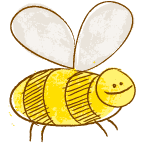Queen Bees
Truly hive royalty! Queens are selected when they're still eggs. The egg is fed lots of royal jelly, a nutrient-rich gelatinous substance. Queen bees even get specially built cells in the hive to fit their larger size. There's just one queen per hive, and she can lay up to 2,000 fertilized eggs in a single day! Queen bees can live up to 5 years.





















